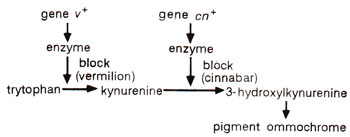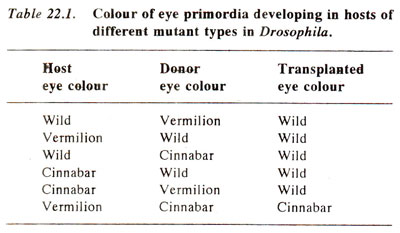
Fig. 22.3. Eye transplantation experiments in Drosophila, showing autonomous and non-autonomous development of implanted embryonic eye discs into various phenotypes.
Before having initiated his work on
Neurospora, G.W. Beadle had conducted eye transplantation experiments in
Drosophila in collaboration with
B. Ephrussi in Europe. It is due to the frustration he had with this work, that he subsequently shifted to
Neurospora. Beadle and Ephrussi transplanted larval embryonic eye primordia from one
mutant type into another and studied the development of pigment in such transplanted eyes. The results of these transplantation experiments are presented in Figure 22.3 and Table 22.1.

Fig. 22.3. Eye transplantation experiments in Drosophila, showing autonomous and non-autonomous development of implanted embryonic eye discs into various phenotypes.

Fig. 22.4. Steps in biosynthesis of eye pigment in Drosophila.
It can be noticed in Table 22.1 that, when wild type eyes are transplanted on a vermilion or cinnabar host, wild type eyes develop, indicating that phenotype of eyes in this case is independent of host. In reciprocal transplantations, when vermilion or cinnabar eyes are transplanted on wild type, these transplanted eyes also develop into wild type, because a diffusible substance (probably an enzyme) from host helps the transplanted eyes to develop into wild type.
Crucial results were obtained when reciprocal transplantations were made between vermilion and cinnabar. When vermilion eye is transplanted on cinnabar, a wild type eye develops, indicating that a diffusible substance from cinnabar enables the transplanted vermilion eye to develop into wild type. However, when cinnabar eye is transplanted on vermilion, no diffusible substance is available which would enable cinnabar to develop into wild type. This indicated that vermilion colour appears due to a block appearing earlier in biosynthetic pathway than in case of cinnabar. The suggested biosynthetic pathway is shown in Figure 22.4.

Fig. 22.4. Steps in biosynthesis of eye pigment in Drosophila.








